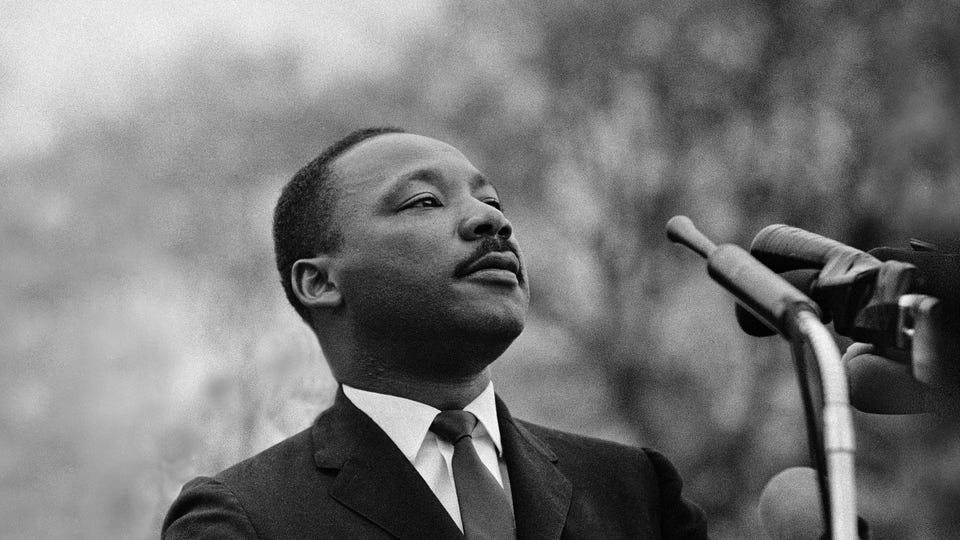Why The Racial Wealth Gap Hasn’t Shrunk Since MLK’s Death: A Look At The Numbers

Topline
In the years since 1968 when civil rights icon Martin Luther King Jr. died, the racial wealth gap in the U.S. soared and Black Americans continued to accumulate wealth at much smaller rates than their white counterparts—but there’s one silver lining: the Black middle-class has gained momentum.

Dr. Martin Luther King, Jr. speaking before crowd of 25,000 Selma To Montgomery, Alabama civil … [+] rights marchers.
Getty Images
Key Facts
King was assassinated on April 4, 1968, while he stood on his second-floor balcony of the Lorraine Motel in Memphis, where he was visiting in support of a sanitation workers strike.
The summer before had been a brutal one for King and other civil rights activists as protests and riots against racial equality broke out across the country, convincing President Lyndon B. Johnson to set up the Kerner Commission, which released an infamous 1968 report a month before King’s death, explaining the link between institutional racism and poverty and inner-city violence.
The persistent work civil rights activists put into seeing equal rights in the U.S. led to the passage of several bills, which targeted discrimination in areas such as political, economic and social struggles.
These bills included the Fair Housing Act of 1968, the Voting Rights Act of 1965, the Civil Rights Acts of 1964 and changes to the Fair Labor Standards Act, which set a federal minimum wage, according to a report by the Federal Reserve Bank of Minneapolis.
These laws helped reduce the racial wealth gap from a ratio of eight to one in 1960 and then five to one in 1980—but between 1980 and 2020, the racial wealth gap increased by “the equivalent of 0.1 percent a year,” according to the report.
The main driver of this was the difference in capital gains (previously accumulated wealth and the interest earned on the wealth), and the top .1% of Americans owning more than double the percentage of national wealth in 2020 than they did in 1980.
According to the Federal Reserve, the average Black household earns around half as much as the average white household, and owns only between 15% and 20% as much net wealth.
Unemployment rates for Black Americans have historically been twice the amount of white Americans, and the unemployment rate for Black Americans in the fourth quarter of 2022 was 5.5%, compared to the 2.9% rate for white Americans, according to data from the U.S. Bureau of Labor and Statistics.
Crucial Quote
“Segregation and poverty have created in the racial ghetto a destructive environment totally unknown to most white Americans,” the 1968 Kerner Commission report stated.
How The Racial Wealth Gap Has Changed Since King’s Death
1968: Adjusted for inflation, middle-class Black families had an average household wealth of about $6,600 in 1968 compared to around $71,000 in wealth for white middle-class households, according to the Survey of Consumer Finances (a 10.7 times greater amount). 1988: The racial wealth gap continued to rise, with average middle-class Black families’ household wealth rising to $15,000 by 1988, while middle-class white families’ wealth soaring to about $115,000—a $100,000 difference (7.7 times greater). After an increase in middle-class household wealth for Black families in 2000 and an even sharper increase for middle-class white families, both groups saw a decline in household wealth by 2008—but Black households were looking at an average of around $18,000 in wealth, while white households’ wealth was still significantly higher, averaging about $160,000 (8.9 times greater). According to the Senate’s Joint Economic Committee, the median wealth held by white families in 2019 was $171,000 while Black families had a median wealth of $17,000 (back to an above 10 times greater difference), meaning Black families had one sixth the wealth of white families in 2019.
What’s Driving The Racial Wealth Gap
Several factors have caused the wealth gap. One of them being white families bring home more money than their Black counterparts. The U.S. Department of Labor reported on average, white workers bring home $1,046.52 weekly, while Black workers bring $791.02 home weekly. This means Black Americans earn $.76 for every dollar white Americans make. Another factor is the lower rate of homeownership among Black Americans compared to white Americans. In the second quarter of 2022, homeownership rates for Black households was 45% compared to 75% for white households, according to the U.S. Department of Treasury. Homeownership is important because it facilitates wealth accumulation in the early years and provides stability for retirement in the later years, the report said. The Brookings Institute found lower rates of homeownership among Black Americans are directly tied to systemic racism and anti-Black policies, which affect predominantly Black neighborhoods and Black people, leading to an increased likelihood of mortgage rejection.
Economic Gains In Black American Households
Although the racial wealth gap remains a pressing issue, the Black middle-class has made progress over the years. An analysis by Stateline found the percent of Black middle-class households is approaching the percent of white middle-class households in several states. In Texas, for example, 48% of Black households are middle-class where 51% of white households are, and in California, 44% of Black households are considered middle-class compared to 47% of white households. Maryland had the largest number of Black middle-class households in 2021, with 50% classified as middle-class. The middle-class became more diverse from 1979 to 2019, according to the Brookings Institute. White households made up 84% of the middle-class in 1979 and Black households made up just 5%. By 2019, white households still remained the majority, making up 59% of the middle-class, but the share of Black households grew to 12%.
Further Reading
The black-white economic divide is as wide as it was in 1968 (Washington Post)
Migrating Professionals Grow Black Middle Class in the South and West (Stateline)
Black-White Wealth Gap Getting Worse, 160 Years of US Data Show (Bloomberg)
